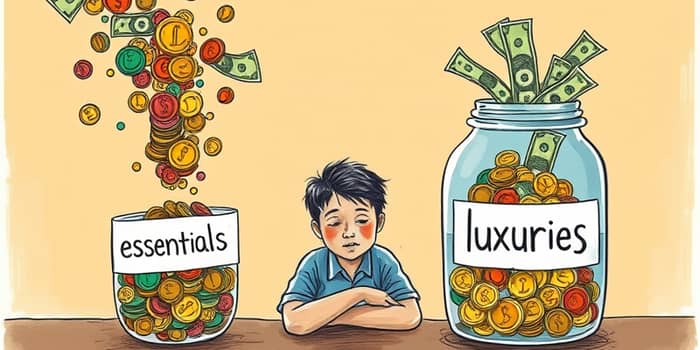
Recognizing the difference between essential costs and discretionary expenses is a transformative step toward lasting financial well-being. By carefully categorizing your outlays, you can unlock the power to save more, reduce stress, and pursue long-term goals.
At its core, the distinction between needs and wants rests on necessity versus desire. Essentials for basic living and work include housing, groceries, utilities, transportation, insurance, and minimum loan payments. Without these, daily life grinds to a halt.
Conversely, wants enhance comfort or pleasure but are not vital. Dining out, entertainment subscriptions, travel, luxury goods, and hobbies all fall into this category. While these enrich experiences, they can strain budgets if unchecked.
Proven models guide allocation to keep spending healthy and sustainable. The popular 50/30/20 rule recommends assigning 50% of income to needs, 30% to wants, and 20% to savings and debt reduction. By doing so, you allocate fifty percent to needs while preserving financial growth.
Other approaches include the 70/20/10 rule, which groups needs and wants into 70% of income, reserves 20% for investments or savings, and dedicates 10% to debts or charitable giving. Meanwhile, experts suggest keeping housing costs below 28% of gross monthly income, though high cost-of-living regions may push that threshold higher.
Building a mindful spending plan starts with accurate data and honest categorization. Follow these sequential steps to create an actionable budget:
With clear visibility into where every dollar goes, you can make strategic choices that align spending with values and goals.
Understanding national and generational habits provides valuable perspective. Consumer spending drives roughly 70% of the U.S. economy, surpassing $13 trillion annually. In 2022, each American spent an average of $72,967—a 9% increase year over year.
Housing commands the largest share at 32.9% of expenditures. Together with transportation, food, insurance, pensions, and healthcare, the top five categories represent 83.2% of total outlays. Purely discretionary categories such as entertainment, apparel, and cash contributions account for just 10.4%.
Gen Z, however, shows distinct preferences. Over half prioritize tech when splurging, and nearly half spent most on fashion in 2022. They allocate more to electronics and wellness products, and less to travel, compared to older demographics. These patterns underline how values shape budgeting choices.
Once needs and wants are clearly distinguished, targeted strategies can drive better outcomes:
Emotional triggers, social pressure, and advertising often blur lines between needs and wants. A smartphone upgrade can feel indispensable, while a modest data plan suffices. Recognizing these influences empowers you to resist impulses and choose consciously.
Generational trends reflect shifting values. Gen Z’s tech focus and wellness spending illustrates how personal priorities shape budget decisions—if you don’t understand changing spending priorities, you risk undermining long-term objectives.
Distinguishing essentials from luxuries yields several lasting advantages:
Separating wants from needs is more than an exercise—it’s a mindset that champions intention, discipline, and foresight. By adhering to proven budgeting frameworks, leveraging data on actual spending, and applying targeted strategies, you can steer your finances toward stability and freedom.
Embrace this clarity and watch as small, purposeful adjustments accumulate into profound progress. With every budget review and thoughtful purchase, you reinforce the habits that underpin lasting prosperity.
References













